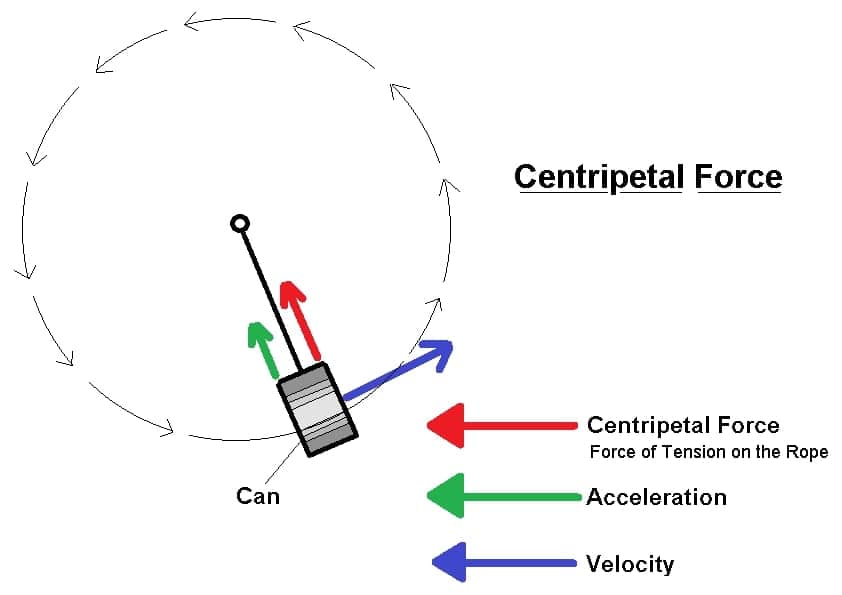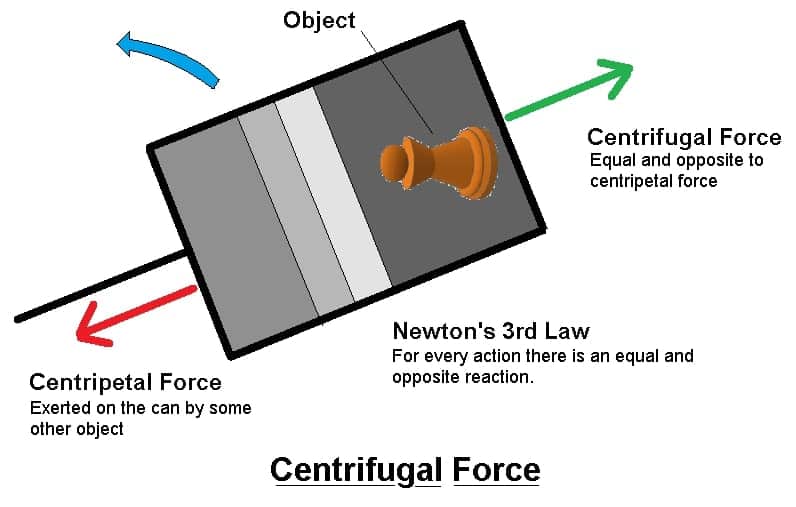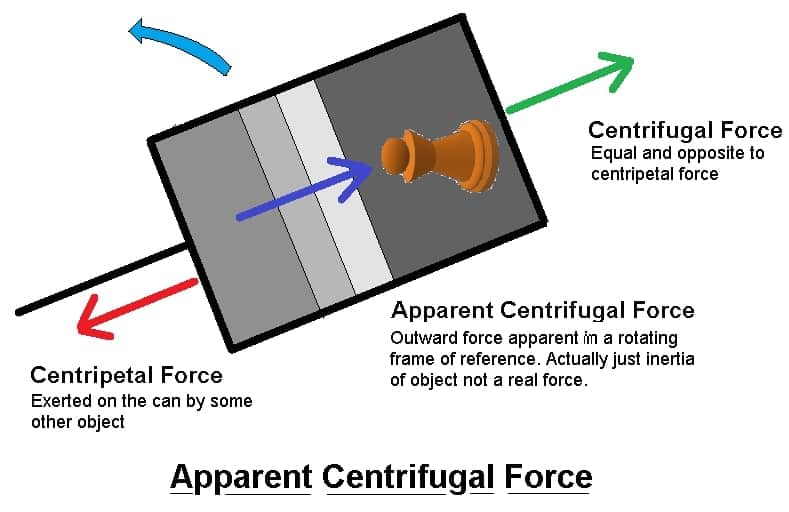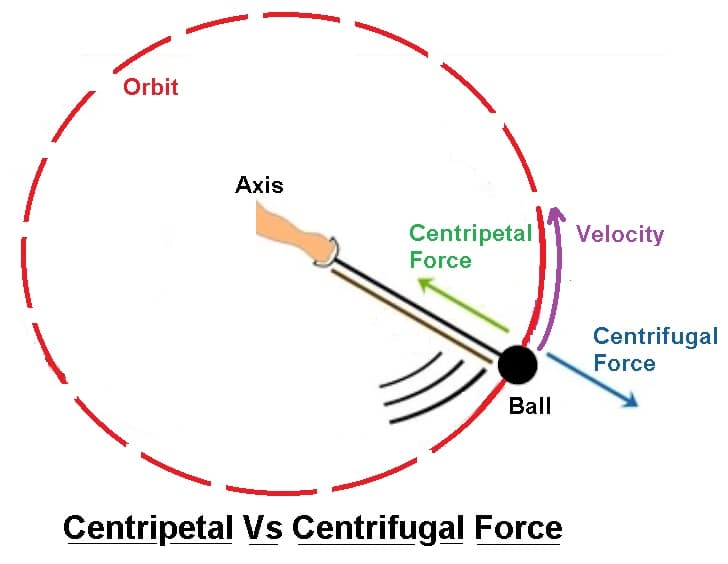In this article, you’ll learn what is centripetal vs centrifugal force? and how they work in real life. Its definition, working, example, and the difference between centripetal vs centrifugal force are explained with pictures.
In addition, you can also download the PDF file of this article at the end.
What is Centripetal Force?
Centripetal force is defined as the force that causes an object to follow a curved path and is directed towards the center around which the body is moving. Or in simple words, centripetal force is a force that acts to keep an object moving along a circular path.
Working of Centripetal Force
Imagine a rope swinging around a circle, with a can attached to its end. The can is in a constant state of acceleration since its velocity is constantly changing due to its circular path. Acceleration of the can is caused by a net force acting on the object.

This always pulls an object towards the center of a circle, without this force an object will continue moving in a straight line motion. The centripetal force is tension on the rope.
The centripetal force is equivalent to the mass velocity squared divided by the radius. As these variables change so will the centripetal force an increase in mass or velocity or a decrease in radius will result in an increase in the centripetal force.
A decrease in mass or velocity or an increase in radius will result in a decrease in the centripetal force. If the rope is cut the can will no longer maintain a circular path and it will fly in a straight line tangent due to Newton’s first law of inertia.
Read Also: The Complete List of Mechanical Properties That Every Mechanical Engg Should Know
Examples of Centripetal Force
- The force of gravity pulls the moon towards the center of the earth, this pole is the centripetal force keeping the moon in orbit around the earth. If earths gravity ceased to exist the moon would fly off into the space in a straight line.
- Another example of centripetal force is the force that bind mud to a tire as it rotates. As the rotation speed of the tire increases, the centripetal force will not be great enough to hold the mud onto the tire and the mud will fly off the tire in straight line tangets.
Centripetal Force Formula
The centripetal force is usually calculated by the formula given below.

Where,
- Fc = Centriptal force
- m = Mass of the object
- v = Velocity
- r = Radius
Read Also: What are Definitions and Terms Used In Mechanical Measurements?
What is Centrifugal Force?
It is an external imaginary force experienced by an object that moves in a circular path away from the center of rotation. The theory of centrifugal force is used to define the physics of rotating devices such as a centrifuge, centrifugal pump, centrifugal governors, and more devices.
Working of Centrifugal Force

As we discussed with the can that was attached to the string. The centripetal force is the force that creates the tension on the string. There are two perspectives in this example, outside of the can and inside the can.
As Newton’s third law states for every action there is an equal and opposite reaction from outside of the can there should be an outward reaction force to the centripetal force. This center fleeing force is known as the centrifugal force.
The reactive centrifugal force is the reaction force to a centripetal force. The can undergoing curved motion constantly accelerates towards the axis of rotation. This centripetal acceleration is provided by a centripetal force which is exerted on the can by some other object.
This is the reactive centrifugal force and is directed away from the center of rotation and exerted by the rotating can on the object that generates the centripetal acceleration. If the object is placed inside the can, it appears that the object has an outward force that pushes it towards the bottom of the can and away from the center of rotation.
Apparent Centrifugal Force

The apparent centrifugal force is most commonly introduced as an outward force apparent in a rotating frame of reference. It is apparent or imaginary in the sense that it is not part of interaction but actually the inertia of the object. The object naturally wants to travel in a straight line but the centripetal force does not allow it.
This type of force is associated with describing motion in a non-inertial reference frame and is referred to as a fictitious or inertial force. The reactionary and apparent centrifugal force is not a real force. Hence, it is a result of the rotation, not a force.
The apparent centrifugal force is really the inertia of the object. A more accurate definition for centrifugal force would be the lack of centrifugal force.
Example of Centrifugal Force
- The Weight of an object at the poles and on the equator.
- Vehicle slide off while making a turn or slips while driving around the curve.
Centrifugal Force Formula
The centrifugal force is usually calculated by the formula given below. Consider the velocity of the object is known, and it is calculated by,

Where
- V = velocity of the moving can
- r = it is the distance of the moving can from the center
- m = mass of the moving can
If the angular velocity is known, and it is calculated by,

Where
- ω = angular velocity
- r = distance of the moving can from the center
- m = mass of the moving can
Read Also: What are the 3 Laws of Thermodynamics? [Explained with Pictures]
Difference Between Centripetal Force and Centrifugal Force
Following are the main difference between centripetal vs centrifugal force:

| Comparison Based On | Centripetal Force | Centrifugal Force |
|---|---|---|
| Definition | It is defined as the force which acts to keep an object moving on a circular path and is directed towards the center of the circle. | It is defined as the force is an external imaginary force experienced by an object that moves in a circular path away from the center of rotation. |
| In Simple Words | Centripetal force is the force required for circular motion. | Centrifugal force is the force that forces an object to escape from the center. |
| Nature | It considers a real force and has its effects on real life. | It is considered an imaginary force but it also has a real effect. |
| Direction of motion | It causes a direction to rotate towards the center. | It causes a direction to travel straight without turning. |
| Observation | This is seen from an inertial frame of reference. | This is seen from a non-inertial frame of reference. |
| Formula | F = mv²/r in the opposite direction to the centrifugal force. | F = mv²/r in the opposite direction to the centripetal force. |
| Example | The moon orbiting around the Earth. | Vehicle slide off while making a turn. |
| Applications | In a roller coaster, it makes sharp turns along the ends with the help of centripetal force which prevents it from moving away from the tracks. | You must have seen the ride of Gravitron, in which the centrifugal force gives pleasure to the rider by making him feel in the air. |
Wrapping It Up
As I discussed above, centripetal force is the force required to make an object move in a circle. Whereas centrifugal force is an inertial force that appears to act on all objects when viewed in a rotating frame of reference.
So for now, I hope that you have learned about the “Centripetal vs Centrifugal Force“. If you have any questions or doubts about this article, feel free to ask in the comments. If you got this article helpful, please share it with your friends.
Want free PDFs in your inbox? Then subscribe to our newsletter.
Download PDF of this article:
You might like to read more in our blog:
- What is Pascal’s Law? It’s Explanation, Formula, Derivation & Applications
- What are the application of Bernoulli’s Equation? Assumptions & Equation [PDF]
External Links:
Thank you so much. It helped a lot to clear my concepts about this topic.
You’re welcome!
Thanks Much for this Very Informative Article. I have been waiting for this a long back. Tysm Brother……
You’re most welcome and I appreciate your comment. Keep visiting.